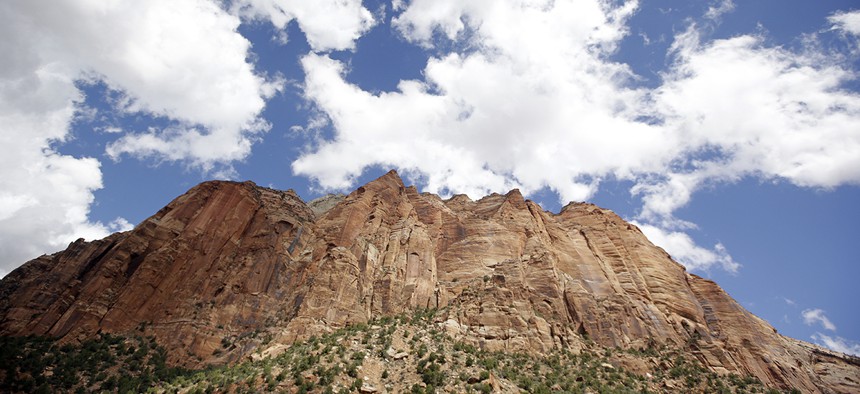How Mobile Data Could Help Manage the National Parks

Zion National Park, near Springdale, Utah. Rick Bowmer/AP File Photo
The data could be used to create better park experiences despite overcrowding.
The National Park Service wants to collect more data on park visitors to improve the way it manages land and preserves natural resources amid record-setting attendance rates.
The national parks have attracted more visitors in recent years than any other period in their 114-year history, but as more people set out to experience the parks’ natural beauty, they increasingly find the great outdoors is swarmed by other humans.
But NPS thinks the key to keeping attendees moving efficiently through the parks could lie in their personal data. Today the agency is looking for ways to use geolocation data and other information from mobile devices to better manage visitors’ experience and plan long-term infrastructure projects in and around the parks.
“Balancing visitor access with the preservation of resources and visitor experience is likely the most important issue facing the NPS in the coming decades,” agency officials wrote in a request for information published last month. “Increasing visitation creates a fair amount of urgency for many park units to collect data regarding visitor use patterns.”
Nearly 331 million recreational visitors stopped at the parks in both 2016 and 2017, and the intermountain region—which includes Grand Teton, Yellowstone, Rocky Mountain, Zion and Grand Canyon national parks—saw attendance grow 46 percent during the last five years.
“Unmanaged visitor use can inadvertently damage the fundamental resources and values and qualities that attract people to these areas,” Kerri Cahill, branch chief of the NPS Planning Division, told Nextgov. “Planning for visitor use management allows the agency to strategically evaluate and plan for how to best protect resources and visitor safety, encourage access and improve experiences.”
In the RFI, NPS asked respondents to outline the types of data available on visitors and how to use that information to understand individuals’ demographics and travel patterns, as well as broader trends in national park attendance and land use. Officials also want to figure out whether that data can help measure how changing park policies affect visitors’ travel patterns.
NPS also asked for ways to use big data to inform future infrastructure improvements and potential transportation expansions between different regions.
Last year NPS put together a long-range transportation plan aimed at overcoming the challenges of rising park attendance over the next two decades, which is scheduled for updates every five years to accommodate for changing environmental, social and financial conditions. The agency’s intermountain regional office published a similar strategy in 2014, meaning officials plan to reassess the program next year.
Visitor data could ultimately help NPS make better decisions regarding those long-term plans, said Erica Cole, an NPS Planning Division transportation planner, in an email to Nextgov.
Cole said the initial data collection initiatives might focus specifically on the agency’s intermountain region, but the RFI is intentionally broad, and responses could eventually inform data analytics efforts at different federal land management agencies, including the U.S. Forest Service, U.S. Fish and Wildlife Service, Bureau of Land Management, and Army Corps of Engineers.
Mobile connectivity can vary heavily based on geography and topography of different regions, but NPS plans to explore data collection methods that work broadly across all federal lands, officials wrote in the RFI.
NPS on Monday extended the deadline for responses to Sept. 11.



